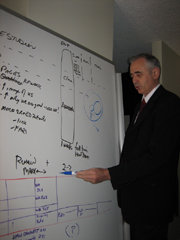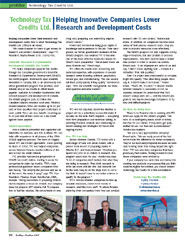Case Study: Process Makes Perfect
Technology Tax Credits' expert SR&ED claim process returns research dollars to a Calgary-based tech company; reinvested dollars advance well site gas monitoring technology, growing the company from small start-up to multi-million dollar acquisition for a multi-national.Overview
Bryan Korolischuk (CMA, P.Geoph), Technology Tax Credit's Vice President of Finance, recounts the start of the long-term relationship with Scott and Wellsite Gas Detection: "We met at an industry trade show in Calgary, and a week later we visited Scott and his partner at their office to discuss the projects they were developing, and how much time and money they had spent on each project. Based on a one-hour session, we determined that there was the basis for a successful SR&ED claim."
The Process
 Wellsite was developing a Wireless Hydrocarbon Monitor to measure hydrocarbon volumes at gas well sites. Specifically, the company was trying to integrate infrared sensors with wireless communications in a unit that could withstand harsh drilling rig environments. Wellsite's project was a prime candidate for receiving SR&ED tax credits because it was technically challenging and reached far beyond the industry standard.
Wellsite was developing a Wireless Hydrocarbon Monitor to measure hydrocarbon volumes at gas well sites. Specifically, the company was trying to integrate infrared sensors with wireless communications in a unit that could withstand harsh drilling rig environments. Wellsite's project was a prime candidate for receiving SR&ED tax credits because it was technically challenging and reached far beyond the industry standard. "At that time, infrared based monitors were not used for gas measurement - the industry standard was based on hot-wire or catalytic bead methods," says Bryan. "Also, existing systems were not wireless, but relied on cables and hoses that ran through drilling platforms to collect gas measurements. Wellsite was definitely pushing the boundaries of hydrocarbon measurement technology."
In addition to identifying Wellsite's technological advancements, Technology Tax Credit's team also pointed out that Wellsite could claim R&D work dating back to 2001 - almost two years' worth of expenses, which would add to the overall refund. In a follow-up interview, Technology Tax Credits collected the necessary information to compile a thorough technical report and complete the financial SR&ED forms.
Results & Impact
The wireless gas monitor became so successful that Wellsite Gas Detection Inc. was acquired by National Oilwell Varco for several millions in 2004. As a company principal, Scott Gunn earned a return significantly greater than just his initial R&D investment, only one year after their first meeting with Technology Tax Credits.
Gunn has since launched a new company, Geological Rentals and Services Inc., and continues to use Technology Tax Credits' expert services to recoup the R&D expenses for his new business.



